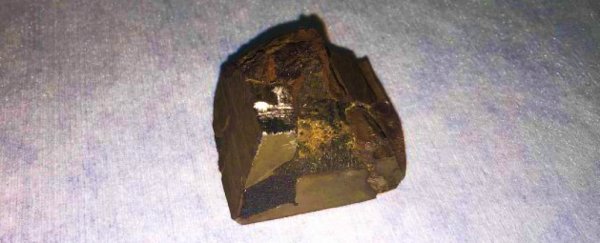Scientists have found naturally occurring superconducting materials in extraterrestrial objects for the first time, discovering superconductive grains embedded inside two distinct meteorites that crash-landed on Earth.
The discovery is just the latest to show that meteorites are much more than space debris that falls out of the sky. Recent investigations have turned up meteorite-borne deliveries of possible extraterrestrial proteins, minerals we've never encountered, and materials older than the Solar System itself. But we've never seen something quite like this before.
Superconductivity is a set of physical properties that ensures 'perfect' electrical conductivity in a material, meaning all electrical resistance inside the material vanishes, among other effects. This prized phenomenon is incredibly rare in natural materials that haven't been specially treated – or, at least, it's rare on Earth.
In the distant sky above, things could be very, very different, researchers say, with extreme environments in space creating exotic material phases not seen on Earth, via astronomical events that can unleash incredibly high temperatures and extremely high amounts of pressure.
Because of this, the thinking goes, meteorites could be good candidates for finding naturally formed superconducting materials forged in the strangeness of space. The only problem is, previous searches have never identified any such superconducting compounds. At least, not until now.
In a new study led by researchers from UC San Diego, scientists investigated fragments from 15 different meteorites, using a technique called magnetic field modulated microwave spectroscopy to detect traces of superconductivity inside the samples.
They got two hits: one, in an iron meteorite called Mundrabilla, one of the largest meteorites ever found, which was discovered in Australia in 1911; the other, a rare ureilite meteorite called GRA 95205, located in Antarctica a quarter-century ago.
According to the team's measurements, which also drew upon vibrating sample magnetometry (VSM) and energy dispersive X-ray spectroscopy (EDX) methods, both of these space rocks contain minute amounts of extraterrestrial superconductive grains.
"Naturally occurring superconductive materials are unusual, but they are particularly significant because these materials could be superconducting in extraterrestrial environments," says physicist and nanoscientist James Wampler.
"These measurements and analysis identified the likely phases as alloys of lead, indium, and tin."
It's a major find – and not only because it's a first in meteorites.
"Even the simplest superconducting mineral, lead, is only rarely found naturally in its native form, and, to our knowledge, there are no previous reports of natural lead samples superconducting," the authors explain in their paper.
"In fact, we are only aware of one previous report of superconductivity in natural materials, in the mineral covellite."
That said, the fact that these superconducting grains were discovered in two separate meteorites – and from such a small sampler overall of space rocks – means more of these superconducting phase materials are likely to exist in astronomical environments, and their superconducting properties could in turn have all manner of effects on their extraterrestrial surroundings.
"Superconducting particles within cold regions of space could have implications on the structure of stellar objects," the team writes.
"Specifically, superconducting particles could sustain microscopic current loops generated by transient fields and contribute to nearby magnetic fields."
Just how substantial these phenomena would end up being is anybody's guess, but there are lots of new questions to ask, and now's the time to get wondering.
The findings are reported in PNAS.
